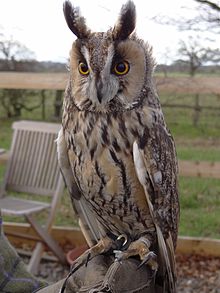Long eared owl
| Long-eared owl | |
|---|---|
 |
|
| At a Falconry Centre in England | |
| Scientific classification | |
| Kingdom: | Animalia |
| Phylum: | Chordata |
| Class: | Aves |
| Order: | Strigiformes |
| Family: | Strigidae |
| Genus: | Asio |
| Species: | A. otus |
| Binomial name | |
|
Asio otus (Linnaeus, 1758) |
|
 |
|
| Range of A. otus Breeding range Year-round range Wintering range | |
| Synonyms | |
|
|
The long-eared owl (Asio otus), also known as the northern long-eared owl, is a species of owl which breeds in Europe, Asia, and North America. This species is a part of the larger grouping of owls known as typical owls, family Strigidae, which contains most species of owl. The other grouping of owls are the barn owls, family Tytonidae.
The scientific name is from Latin. The genus name Asio is a type of eared owl, and otus also refers to a small eared owl.
The long-eared owl is a medium-sized owl, 31–40 cm (12–16 in) in length with an 86–100 cm (34–39 in) wingspan and a body mass of 178–435 g (6.3–15.3 oz). It has erect blackish ear-tufts, which are positioned in the centre of the head. The ear-tufts are used to make the owl appear larger to other owls while perched. The female is larger in size and darker in colouration than the male. The long-eared owl's brownish feathers are vertically streaked. Tarsus and toes are entirely feathered. Eye disks are also characteristic in this species. However, the eye disks of A. otus are darker in colour or rusty-orange. This nocturnal species is perhaps most easily seen perched in a tree in its daytime roost, sometimes in small groups during the winter months. There are about six thousand long eared owls in The United States, and fifty thousand in the whole world.
Over much of its range, long-eared owls occur with the similar-looking short-eared owl. At rest, the ear-tufts of the long-eared owl serve to easily distinguish the two (although long-eared owls can sometimes hold their ear-tufts flat). The iris-colour differs: yellow in short-eared, and orange in long-eared, and the black surrounding the eyes is vertical on long-eared, and horizontal on short-eared. Overall, the short-eared owl tends to be a paler, sandier bird than the long-eared. There are a number of other ways in which the two species differ which are best seen when they are flying:
The long-eared owl's breeding season is from February to July. This bird is partially migratory, moving south in winter from the northern parts of its temperate range. Its habitat is forest close to open country. Overall, these owls are secretive, and are rarely seen.
...
Wikipedia

